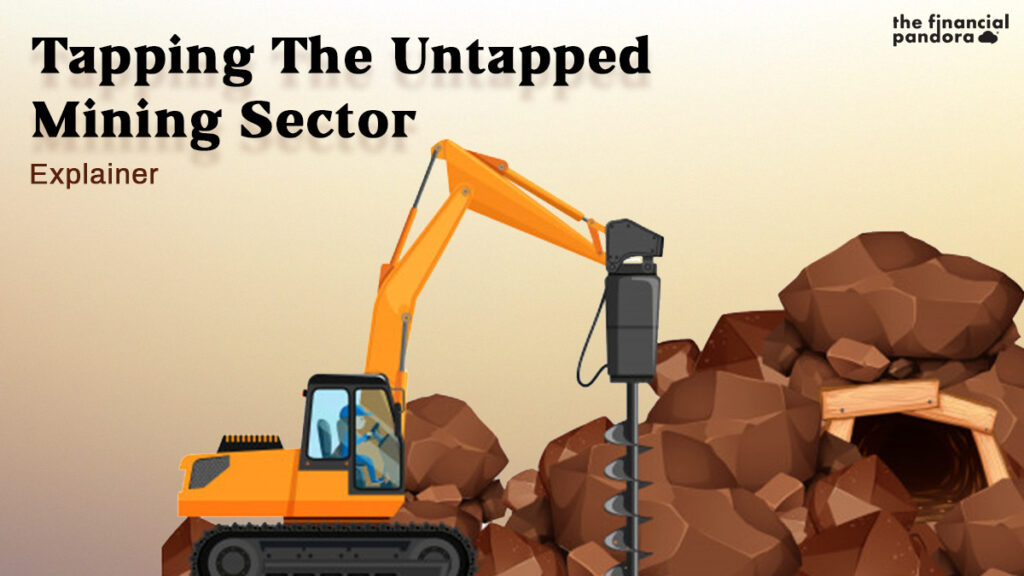We repeatedly hear proclamations like “India emerges as the second largest crude steel producer in the world” or “Second largest coal producer in the world.” Then, why are mining sector imports increasing annually? Why does the mining sector only contribute a fractional amount to the GDP? Is there a lack of investments? What’s holding us back from growth?
Let’s dig in.
Coal and metal mining is a core sector that underpins India’s considerable manufacturing and infrastructure industries. India currently produces 95 minerals (four fuel, three atomic, 10 metallic and 23 non-metallic and 55 minor minerals).
However, this only scratches the surface. 5.71 lakh square km has been identified by the Geological Survey of India (GSI) as area of Obvious Geological Potential; only 10% of this is being mined. India has significant reserves of coal, bauxite, titanium, chromite, natural gas, diamonds, petroleum, and limestone that are yet to be made productive. Mining has the potential to provide 12% of all non-farm jobs. With such large reserves, we share similar potentials like South Africa and Australia, whose contribution to GDP is at 7% and 7.5% whereas India is only 1.75%.
So, why is it still the Bottom-Dog?
Well, the answer is simply – Intervention and Inefficiency.
The mining sector in India is heavily regulated and the government interventions have incessantly downplayed private sector interests and left them at marginal status. This leaves us with an underperforming state monopoly of the PSUs.
Looking at coal mining for example. In 1973, the government transferred all coal holdings to public sector company Coal India Ltd through the Coal Mines Act. Currently, the sector is a virtual monopoly of the public sector behemoth CIL currently runs 117 mining projects and provides about 85% of the country’s domestic coal production. Another public sector firm, “Singareni Collieries Company” accounts for the majority of the rest. And these companies aren’t exactly giving stellar results. Production output levels are insufficient to even satisfy domestic demand. India has the world’s fourth largest coal reserves but had to import 247.1 million tonnes of coal in 2019-20.
This is not only confined to coal but in other major minerals also. the country’s mineral sector is heavily dependent on imports. In FY19, the value of domestic production of all major minerals (excluding coal, lignite and minor minerals) was Rs 58,638 crore, while the import value of vital minerals/metals, at Rs 4.34 trillion — almost seven times higher than domestic production.
So, what’s the government doing?
Last year, as part of the Aatmanirbhar mission, the Central government announced structural reforms for the mineral sector to boost mineral production, employment generation and bring in state-of-the-art technology, especially in exploration of minerals. On 22 March, 2021 Parliament cleared the Mines and Minerals (Development and Regulation) Amendment Bill, 2021, bringing in many reforms to India’s untapped mining industry.
1. Let’s Commercialize Mining
In 2020, the coal ministry put up 41 mines for auction and in 2021, it will put 67 mines on the block. Commercial coal mining allows the private sector to mine coal commercially on a revenue-sharing basis without placing any end-use restrictions. The private firms have the option of either gasification of the coal or exporting it.
The complete freedom to decide on sale, pricing, and captive utilisation has attracted many private sector firms to participate in the auction process. Further, with 100% foreign direct investment allowed in the coal sector, global giants like Rio Tinto, Anglo American or BHP can also participate in the auctions.
The government expects more than Rs 33,000 crore of capital investments by FY2027. The boosts ease of doing business with reduced red-tapism over availability of clearances resulting in employment and reduces India’s import bill which lead to a sizeable $15-20 billion in annual foreign exchange outgo.
Why wasn’t this done before?
The coal allocation scam (Colgate) was a political scandal that engulfed the UPA government for allocating 194 coal blocks to public and private enterprises for captive use in a flawed, arbitrary and illegal manner from 1993 to 2010.
Consequently, on 24 September 2014 Supreme Court quashed allocation of 214 out of 218 coal blocks which were allotted to various companies since 1993 and in which it was claimed that around Rs 2 lakh crores were invested. Under the Coal Mines (Special provisions) Act of 2015, the government planned to return these coal blocks to the private sector through auctions. However, end-use restrictions and complex clearances had disincentivized emergence of active private sector participation.
2. Captive vs. Merchant Mines – No Difference?
Firstly, what are captive mines?
Captive mines are those that produce coal or mineral for exclusive use by the company and its subsidiaries that owns the mines without payment of any royalty. Some Captive Coal Mining Companies in India are Steel Authority of India Limited, Adani Power, Hindalco Industries, NTPC Limited and JSW Limited. Until very recently, government intervention restricts captive miners to supply coal and other minerals to supply only to specific end-use domains like steel and thermal power.
On the other hand, non-captive/ merchant mines are ones those that produce as well as sell the fuel/mineral for commercial purpose. This is dominated mainly by PSUs.
What amendments have been made?
a. The Amendment allows captive miners of both coal and other minerals to sell up to 50 per cent of their production after meeting the requirements of the end-use plant and on paying additional royalty to the state government.
b. The bill did away with the end-user sector restriction for allotment of mines such as coal. The Bill provides that no mine will be reserved for particular end-use.
This will augment the production from captive mines, increase coal availability in the market leading to reduction in import of coal. Companies like Jindal Steel & Power Ltd. and Vedanta Ltd., which have recently won iron ore mines will have the flexibility to generate additional revenues from excess production beyond their annual requirements.
3. Reviving Expired Leases – Too Late, Too Bad
Mines are under the ownership of the State governments and mining sector operates under a federal structure where powers to auction off expired leases lies with the States.
a. The bill permits the central government to put a specified time limit till which the states should auction off the leases. Otherwise, if a state government fails to auction off a block within a specified time frame, then the centre can assume control and auction it off themselves.
This amendment comes in light of the fact that of the 143 such mines listed for auctioning; states have auctioned only 7 since 2015. Further, mining lease in relation to 334 blocks expired on 31 March 2020 and only 28 mines have had early auctions. The downside of this being that States might be forced to lease out mines at suboptimal discounted amounts.
b. Further, the amended bill mandates that once a mining lease has been given, production has to start within the next two years, otherwise the lease gets terminated and then they could be put on the auction block once again. All in all, the government hopes to make several mines functional in a short period of time and generate as much employment as they can.
According to HSBC Global Research, these amendments can fast-track planned e-auctions of numerous limestones reserves as well as the rolling auction mechanism for coal reserves. It also curbs procedural and time delays by the states and increases transparency enhancing ease of doing business in this sector.
4. Extending Statutory Clearances
All approvals, regulatory clearances including environmental granted to a lessee shall continue to be valid till exhaustion of mineable reserves and on expiry or termination of the lease, will be transferred to the new lessee.
In the earlier provision, statutory clearances issued to the previous lessee were transferred to the new lessee for a period of two years and new lessee was required to obtain new clearances within these 2 years.
As per Sajjan Jindal, this amendment irons out some operational challenges and gives more certainty to a lessee in terms of production after securing a fresh lease with existing regulatory clearance, given that securing one is a relatively time-consuming process in India. Around 904 mines will expire in the next 10 years, this amendment saves on compliance costing and eliminates regulatory hindrances.
Missed Targets
While the reforms reflect intent, many concerns still remain unaddressed namely:
1. Outrageous Taxation
The effective tax rate on mining in India is 64% against the global average of 34-38%. Mining continues to be the mosta taxed industry anywhere in the world with a cocktail of levies like royalty, GST and contributions by mine lessees to District Mineral Foundation (DMF) and National Mineral Exploration Trust (NMET).
For instance, Indian iron-ore miners are one of the highest royalty payers in the world as compared to other major iron-ore producing countries. Iron ore in India attracts royalty of 15%, while that in Australia attracts 5.35-7.5%, in Brazil 2% and in China 0.5-4%.
With such steep taxes, the flight of foreign capital in mining sector has outweighed the inbound FDI flows. From $592 million in 2010-11, FDI in mining has subsided by more than half to $247 million in FY2019.
2. Environmental Concerns
The government’s launch of coal auctions for commercial coal mining once again triggered the debate around transition to clean energy. India is under growing pressure to improve its climate commitments of the promised 175 GW of renewable power by 2022 and at least 350 GW by 2030.
Investment in coal has been declining as both global mining corporations and international banks try to address the climate crisis. Global mining giants like Rio Tinto, Anglo American, Glencore and BHP are said to have begun the process of divesting their thermal coal assets. Any foreign miners that hope to enter India will find it more difficult to raise investment. Multinational lenders like Deutsche Bank, DBS, Standard Chartered, JP Morgan Chase, and HSBC, will no longer fund new coal-mining projects
Road Ahead - Bright or Bleak?
Post-pandemic infrastructure projects continue to provide lucrative business opportunities for steel, zinc, and aluminium producers. Demand for iron and steel is set to continue given strong growth expectations for the residential and commercial building industry.
The recent government reforms and a strong mining policy give the much-awaited push that the current mining regime requires. Hefty private sector capital investments, transparent process and renewed support from the centre and state will be imperative to ensure that the mining sector is core to reaching the $5tn goal, both in terms of its direct contribution to GDP as well as its ability to grow downstream industries and employment.
For sources click here
This post was written in collaboration with Asif Yahiya Sukri LLP. Asif Yahiya Sukri LLP provides unparalleled personalized financial services to a broad range of clients across different geographical locations. With a presence in the USA, India and the MENA region, they ensure that all of your financial decisions are made carefully and with your best interests in mind. They are innovators who understand what goes into building companies.
You can also reach out to them on info@aysasia.com
Follow Us @
Sources:
Financial Express: https://www.financialexpress.com/opinion/mining-reform-what-the-government-got-right/2205191/
Business Line: https://www.thehindubusinessline.com/opinion/bolstering-the-ongoing-mining-reforms/article33990817.ece
BloombergQuint: https://www.thehindubusinessline.com/opinion/bolstering-the-ongoing-mining-reforms/article33990817.ece




